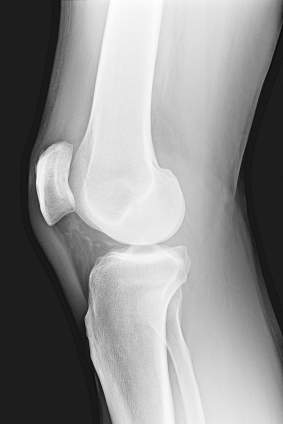Children and adolescents who undergo early surgical reconstruction after suffering a complete tear of the anterior cruciate ligament (ACL) have much better outcomes than those who delay surgery or never have surgery at all, says a 2013 study.[1]
Reviewing data from six studies comparing operative to nonoperative treatment and five studies comparing early to delayed reconstruction, researchers at the Children's Hospital of Philadelphia found that patients in the nonoperative or delayed group were 33 times more likely to have persistent instability in the injured knee than those whose ACL tears were treated surgically.
In terms of return to play, athletes who had early ACL reconstruction were 91.2-times more likely to return to activity at the athlete's previous level of play than those who did not have surgery, who were also much more likely (67% versus 4%) to subsequently suffer a tear of the medial meniscus (the rubbery cartilage band that sit between the upper bone of the thigh (tibia) and the large bone in the lower leg (femur) and serves as a shock absorber reducing the peak contact force experienced, and also reduces friction between the two bones to allow smooth movement in the knee and distribute load during movement).
"Our results suggest that patients are much more likely to return to sports at their previous level of athletic ability after early operative treatment as well as have fewer instances of instability" of the knee or meniscus tears, writes lead author, David E. Ramski, BS, BM, of the Georgetown University School of Medicine.
Challenging decision

The authors recognized that "decision making after ACL injuries in the pediatric patient presents a challenge for surgeons and young athletes."
But, writes Ramski and his colleagues, potential risks to the growth plate with ACL reconstruction must be balanced by the risks of potential damage to the medial meniscus and chondral damage (damage to the shiny, white articular cartilage that protects the ends of bones and allows the joints to glide smoothly with less friction, which may occur as a result of a pivot or twist on a bent knee, similar to the motion that can cause a meniscus tear) in patients treated with nonoperative measures.
Noting the availability of surgical techniques that spare or avoid the growth plates when reconstructing the ACL in skeletally immature patients, and limited evidence that surgery arrests the growth of such plates, "may ameliorate some of the concern related to premature growth arrest or deformity with early reconstruction," the study concludes that the data "favor early ACL reconstruction, particularly for active young athletes who wish to maintain higher levels of physical activity."
Developing consensus?
Based on concerns that surgery might damage growth plates at the end of the tibia and fibia in such skeletally immature patients, the optimal initial treatment for ACL injuries in children and adolescents has not resulted in a clear consensus for initial nonoperative treatment or operative reconstruction.
Whether the study will lead to the development of a consensus that early ACL reconstruction is the optimal treatment remains to be seen.
But for one orthopedic surgeon the answer has been clear for some time. Commenting for MomsTEAM in 2009 on an earlier research paper which came out strongly in favor of early ACL reconstruction by some of the same researchers involved in the current study , Dr. Darren Johnson, Chairman of the Department of Orthopedic Surgery and Director of Sports Medicine at the University of Kentucky, said, "Parents should understand that early reconstruction of the ACL, before any other damage to the knee, gives their child the best chance of a good outcome in the future. Once other structures in the knee are damaged, the final outcome may not be as good, no matter what the surgeon does at the time of reconstruction."
"Telling kids in this age group [who have torn ACLs] to be careful simply does not work, " said Dr. Johnson, "because they do not appreciate the ramifications of their injury and the problems created if they re-buckle their knee."
"The bottom line, even for young kids, is that delaying ACL surgery and reconstruction puts an athletically or even a normally active teenager at significant risk for re-injury, and, most importantly, for injury to other structures in the knee," says Dr. Johnson.
Dr. Johnson says that the only athlete who may delay surgery until his bones are mature is the "coach potato" who does nothing but play XBox, watch television and engage in other sedentary activities. "Unfortunately, kids like that don't tear their ACL; it is the very active teenager who suffer this type of injury," he noted.
ACL reconstruction costs society less
As detailed in a recent study in the Journal of Bone and Joint Surgery,[2] the indirect costs (e.g. lost wages, productivity, and disability) associated with an unstable knee after an ACL tear are substantial. Researchers at KNG Health Consulting in Rockville MD found that ACL reconstruction was less costly (a cost reduction of $4,503) and more effective in terms of quality of life compared with rehabilitation because of the higher probability of an unstable knee associated with rehabilitation.
In the long term, the mean lifetime cost to society for a typical patient undergoing ACL reconstruction was less than half that for rehabilitation ($38,121 versus $88,538).
The finding "demonstrated that access to ACL reconstruction is critical to optimal societal health-care delivery," the study concluded.
1. Ramski DE, Kanji WW, Franklin CC, Baldwin KD, Ganley TJ. Anterior Cruciate Ligament Tears in Children and Adolescents. Am J Sports Med. 2013. doi:10.1177/0363546513510889 (epub December 4, 2013)
2. Mather RC. Koenig L, Kocher MS, et al. Societal and Economic Impact of Anterior Cruciate Ligament Tears. J Bone Joint Surg Am 2013;95:1751-9.








